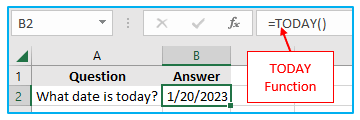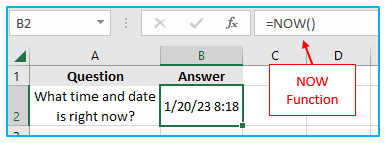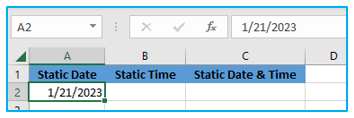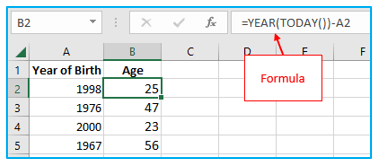Excel TODAY Function is a dynamic tool that streamlines date-related operations, enhancing the efficiency and accuracy of your spreadsheets. By integrating the TODAY function into your Excel tasks, you ensure up-to-date information is always at your fingertips, facilitating better decision-making and planning. Whether for project management, financial analysis, or daily reporting, the TODAY function is indispensable for maintaining current and relevant data. Master this function to make your Excel worksheets more responsive and aligned with the ever-changing present.
This Tutorial Covers:
- When to use Excel TODAY Function
- What it Returns
- Syntax
- Input Arguments
- Additional Notes
- Using of TODAY Function
- Using of NOW Function
- How to enter current time only
- Static Date and Time
- In various ways, TODAY Function
- Age calculation using birthdate
1. When to use Excel TODAY Function?
The Excel Date and Time functions include the TODAY Function[1]. The current date will be calculated and shown. Every time a user opens or modifies a worksheet, it is continually updated. The function’s goal is to retrieve the current date.
When a financial analyst wants to include the current date in a report, they can utilize the TODAY function. It is useful for computing intervals as well. If we are given a database of employees, we can use the function to get each employee’s age as of the current date.
- What it Returns?
A serial date value is returned by the TODAY function. Excel internally maintains dates as serial dates, which indicate the number of days from January 1, 1900.
- Syntax:
Microsoft Excel’s TODAY function has the following syntax:
=TODAY()

- Input Arguments:
The TODAY function has no arguments or parameters.
- Additional Notes:
- Since TODAY() is a volatile function, every time a worksheet is opened or modified, it automatically updates.
- If a TODAY formula does not immediately recalculate, your workbook’s automatic recalculation feature is probably disabled. Go to the Formulas tab > Calculation Options and choose Automatic to enable it once more.
- Use the NOW method rather than TODAY to insert the current date and time.
2. Using of TODAY Function
In blank cell, use Excel’s TODAY function to input today’s date in excel.

Note: The TODAY function does not accept any inputs. When you open the workbook on a different day, this date will immediately update.
3. Using of NOW Function
In blank cell, use the NOW function to input the time and date as they are right now.

Note: The NOW function does not accept any inputs. Every time the sheet is recalculated, this time will automatically update. This occurs whenever you open the worksheet or make a change to any cell. To manually recalculate the worksheet, press F9.
4. How to enter current time only?
Use the formula below to calculate the current time only.
=NOW()-TODAY()

Please take note that dates are kept in Excel as numbers that represent the number of days since January 1, 1900. Internally, times are handled as numbers between 0 and 1. For further details, see our page on date and time formats.
5. Static Date and Time
You can use the next process to get a constant date and time if you require one.
To enter current static date:
Press CTRL +; (semicolon) on your keyboard, to determine today date in excel as a static value.

Please take note that if you open the worksheet on another day, this date won’t change.
To enter current static time:
Press CTRL + SHIFT +; (semicolon) on your keyboard, to determine the current time as a static value.

Please take note that this time will not change if you edit a cell or open the workbook.
To enter current static date & time:
Simply hit CTRL + ; (semicolon), type a space, and then press CTRL + SHIFT + ; (semicolon)to determine the current date and time as a static value.

6. In various ways, TODAY Function
You can use the TODAY function by itself or in conjunction with other functions. The calculations below demonstrate several applications for the TODAY function:
To compute for the previous week:
Use the formula below to calculate the previous week.
=TODAY()-7

To estimate one week from now:
Use the formula below to estimate one week from now.
=TODAY()+7

To determine three months from today:
Use the formula below to determine three months from excel today date.
=EDATE(TODAY(),3)

To determine one year from today:
Use the formula below to determine one year from today.
=EDATE(TODAY(),12)

To calculate 1 year in the past:
Use the formula below to calculate 1 year in the past.
=EDATE(TODAY(),-12)

To determine the month’s first day:
Use the formula below to calculate the month’s first day.
=EOMONTH(TODAY(),-1)+1

7. Age calculation using birthdate
If you know a person’s birth year, you may calculate their age by deducting it from the current year:
YEAR(TODAY())-year of birth
For instance, if the person was born in the year 1998, you may calculate their age using the formula below:
=YEAR(TODAY())-1998
Alternatively, you can enter the year of birth in a different cell and use that cell as a reference in your formula:
=YEAR(TODAY())-A2

Application of Excel TODAY Function – TODAY’s Date Function in Excel
- Dynamic Date Display: Use the TODAY function to automatically display the current date in a spreadsheet, ensuring that the displayed date is always up-to-date without manual input.
- Age Calculations: Calculate a person’s age by subtracting their birthdate from the current date generated by the TODAY function, providing real-time age updates.
- Project Deadlines: Determine the remaining days until a project deadline by subtracting the current date obtained from the TODAY function from the due date.
- Time-Sensitive Conditional Formatting: Apply conditional formatting rules using the TODAY function to highlight tasks or events that are due, overdue, or upcoming, improving task management and prioritization.
- Financial Expiry Dates: Track the expiration of financial instruments or contracts by comparing their expiry date to the current date given by the TODAY function, aiding in timely renewals or closures.
- Data Validation: Use the TODAY function within data validation rules to restrict entries to dates before, on, or after the current date, ensuring data relevance and accuracy.
For ready-to-use Dashboard Templates:
